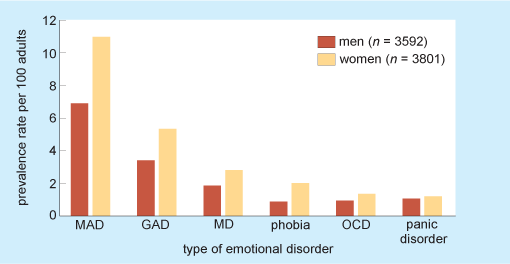1.2 Occurrence and cost of emotional disorders
Whilst anxiety and sadness are everyday emotions, their more serious manifestations can be hugely problematic for a significant number of people.
National statistics compiled by the Government show that in England in 2007, 16.2% (around 1 in 6) of 7325 adults between the ages of 16 and 64 years met the clinical diagnostic criteria for at least one emotional disorder (or common mental disorder; McManus et al., 2009).
Of these, depression and anxiety (or a mix of the two, called ‘mixed anxiety and depression’ or MAD) were by far the most common, as Figure 1 shows. Note that the term prevalence is a scientific term that refers to the number of people experiencing a disorder or illness at a particular time.

Why do you think we consider that the data in Figure 1 show prevalence rates and not simply prevalence as defined in the paragraph above?
Because they show the number of people who have emotional disorders, expressed as a rate per 100 (i.e. a percentage) of the population. Prevalence would just tell us the total number of people with emotional disorders in the population.
The burden to society as a whole is therefore considerable, as anxiety and depression are implicated in 20% (1 in 5) of days lost from work in Britain, and around one in five GP consultations in the UK are about emotional disorders.
Depression has also been linked to the loss of more than 100 million working days in England every year, and it is strongly associated with suicidal thoughts and with suicide, being implicated in around 2500 deaths a year (Thomas and Morris, 2003). McCrone et al. (2007) estimated the total annual cost of depression, including lost employment, in England as at least £7.5 billion a year.
Clearly, it is therefore important to try to understand both emotions and emotional disorders. We start this process here by looking at the nature of emotions and emotional systems.
